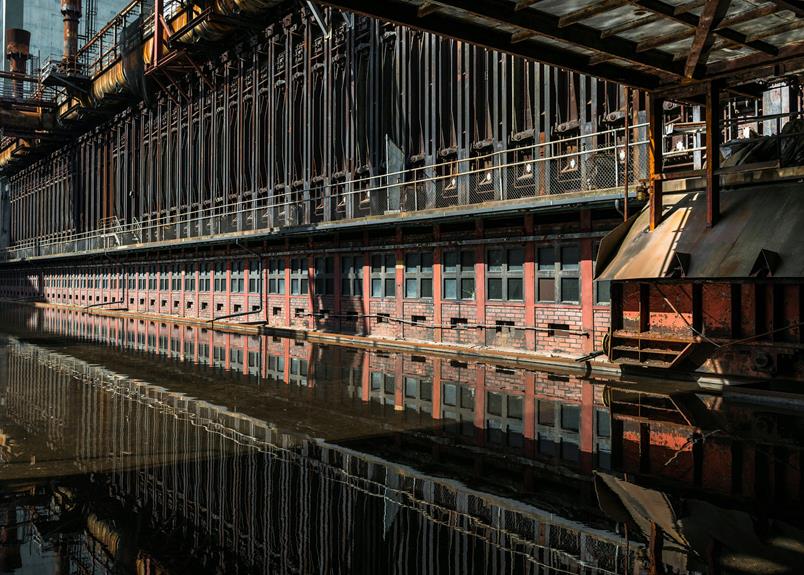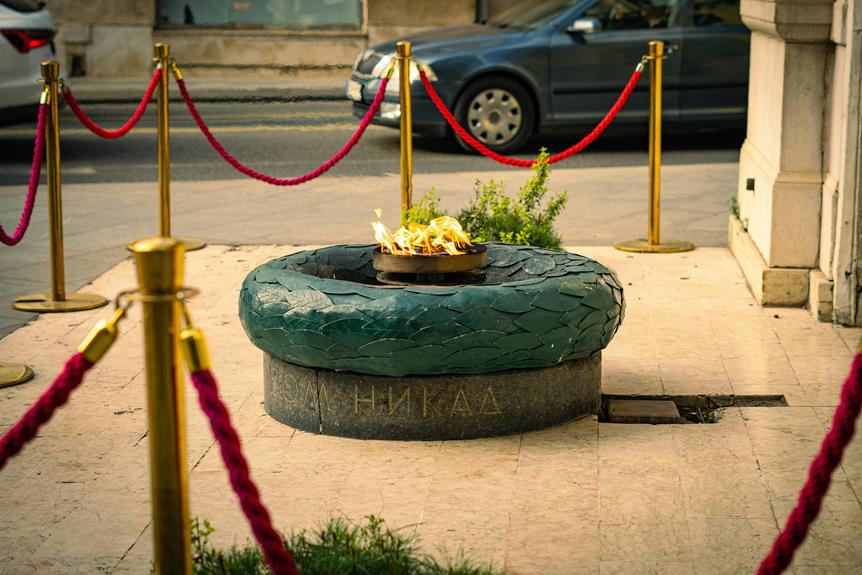The Holocaust Memorial Center in Hungary encapsulates a somber yet imperative chapter in human history, serving as a vital reminder of the atrocities endured by countless individuals during the Holocaust. Beyond its architectural significance, this center stands as a testament to resilience, remembrance, and the pursuit of a more enlightened future. Exploring its exhibits and programs reveals not only a profound glimpse into the past but also prompts reflections on the implications for the present and future. Through its multifaceted approach, the Center beckons visitors to confront the past and consider its reverberations on contemporary societies.
Key Takeaways
- Explores Nazi occupation and 600,000 Hungarian Jews lost during the Holocaust.
- Blends modern architecture with symbolic elements representing good and evil.
- Engages visitors with interactive exhibits, personal stories, and multimedia presentations.
- Offers educational programs, workshops, and virtual tours for in-depth understanding.
- Provides essential visitor information, guided tours, and multiple language guides for a meaningful experience.
Historical Background
The historical background of the Holocaust Memorial Center in Hungary presents a detailed account of the events leading up to and during the tragic period of the Holocaust. The center explores the dark era of Nazi occupation during World War II, when Hungary was under the control of the German forces. This period marked a systematic attempt by the Nazis to annihilate the Jewish population, leading to the deaths of around 600,000 Hungarian Jews.
Despite the overwhelming power of the Nazi regime, there were instances of Jewish resistance in Hungary. The Jewish community in Budapest, for example, organized underground networks to provide hiding places, false documents, and other forms of assistance to those targeted by the Nazis. There were also armed resistance efforts, such as the Budapest Ghetto Uprising in 1944, where Jews fought back against the deportation efforts of the Nazis.
The Holocaust Memorial Center in Hungary serves as a poignant reminder of the atrocities committed during this dark chapter in history. Through its exhibits and documentation, the center pays tribute to the victims, honors the survivors, and educates visitors about the importance of remembrance and vigilance against hatred and discrimination. It stands as a beacon of hope for a future where such horrors are never repeated.
Architectural Design
Elegance and symbolism intertwine in the architectural design of the Holocaust Memorial Center in Hungary. The Center, designed by architects Földes & Co. Architects Office, embodies a blend of modern architecture and profound symbolic elements. The building's sleek lines and minimalist aesthetic create a sense of solemnity and respect, fitting for its purpose as a memorial to the victims of the Holocaust.
The exterior of the Center features a stark, angular design, symbolizing the harsh realities of the Holocaust. The use of materials such as concrete and glass not only gives the building a contemporary look but also serves as a reminder of the industrialized nature of the atrocities committed during that dark period of history. The sharp angles and geometric shapes evoke a sense of order and structure, reflecting the hope for a more just and peaceful world.
Symbolic elements are intricately woven into the architectural details of the Center. The play of light and shadow in the building's design symbolizes the interplay between good and evil, life and death. The careful placement of windows and openings allows natural light to filter into the interior spaces, creating a sense of hope and renewal amidst the solemn atmosphere. Overall, the architectural design of the Holocaust Memorial Center serves as a powerful tribute to the past while looking towards a future of remembrance and reconciliation.
Permanent Exhibits
Intertwining historical narratives with compelling visuals, the permanent exhibits at the Holocaust Memorial Center in Hungary deeply engage visitors in a profound exploration of the Holocaust's impact and legacy. Through a blend of interactive technology and personal stories, the exhibits offer a thought-provoking and immersive experience.
One of the key features of the permanent exhibits is the use of interactive technology, which allows visitors to interact with historical artifacts and documents. Touchscreen displays provide in-depth information about specific events, while multimedia presentations bring to life the personal stories of survivors and victims. This interactive approach not only educates visitors about the historical facts but also fosters empathy and emotional connection to the experiences of those affected by the Holocaust.
Moreover, personal stories play a central role in the exhibits, humanizing the tragedy and highlighting the individual experiences of those who lived through it. Through photographs, letters, and testimonies, visitors gain a deeper understanding of the human cost of the Holocaust and the resilience of those who survived. By sharing these personal accounts, the exhibits create a powerful narrative that resonates with visitors long after they leave the center.
Educational Programs
Educational programs at the Holocaust Memorial Center in Hungary are meticulously designed to provide visitors with in-depth insights into the historical context and lasting impact of the Holocaust. The center offers a range of interactive workshops that engage participants in meaningful discussions and activities aimed at fostering a deeper understanding of the events that transpired during this dark period of history. These workshops are led by knowledgeable educators who guide visitors through thought-provoking exercises designed to promote reflection and critical thinking.
In addition to workshops, the Holocaust Memorial Center provides all-encompassing virtual tours for those unable to visit in person. These virtual tours offer a detailed look at the center's exhibits and allow participants to explore the various artifacts and displays from the comfort of their own homes. Through these virtual experiences, individuals from around the world can engage with the center's content and learn about the Holocaust in a meaningful and immersive way.
Visitor Information
The Holocaust Memorial Center in Hungary provides essential information for visitors to enhance their understanding of the exhibits and historical significance of the site. The Center aims to create a profound visitor experience by offering a range of resources and services. Upon arrival, visitors receive detailed guides that provide background information on the exhibits and the history of the Holocaust in Hungary. These guides are available in multiple languages to cater to international visitors.
One of the key features that enriches the visitor experience at the Holocaust Memorial Center is its interactive displays. These displays allow visitors to engage with the history of the Holocaust in a more immersive way. Through multimedia presentations, personal testimonies, and interactive maps, visitors can gain a deeper understanding of the events that transpired during the Holocaust. The interactive nature of these displays helps visitors connect on a more emotional level with the stories of the victims and survivors.
Additionally, the Center offers guided tours led by knowledgeable staff who provide additional context and insights into the exhibits. These tours enhance the visitor experience by offering a more in-depth exploration of the Center's collections and themes. Overall, the visitor information provided at the Holocaust Memorial Center in Hungary serves to educate, commemorate, and make certain that the memory of the Holocaust endures for future generations.
Frequently Asked Questions
Are There Any Special Events or Commemorations Held at the Holocaust Memorial Center?
Special events and commemorations play an essential role in honoring historical events and individuals. They provide an opportunity for reflection, education, and remembrance.
Special events often involve unique activities or programs that engage participants and raise awareness about significant events.
Commemorations, on the other hand, are solemn occasions that pay tribute to those who have been affected by tragic events. These events serve as a means to preserve memory and guarantee that history is not forgotten.
How Does the Museum Engage With Contemporary Issues Related to Genocide and Discrimination?
Education initiatives and activism engagement are essential components in addressing contemporary issues related to genocide and discrimination. By providing educational programs, workshops, and resources, institutions can raise awareness and promote understanding of these complex topics.
Public outreach and community involvement further amplify these efforts, fostering dialogue and encouraging individuals to take action against discrimination and injustice. This multifaceted approach helps create a more informed and engaged society in combating such issues.
Is There a Virtual Tour or Online Resources Available for Remote Visitors?
Virtual tours and online resources have become essential tools for remote visitors seeking to explore cultural institutions from the comfort of their homes. These digital platforms provide an immersive experience, allowing users to access exhibits, educational materials, and interactive features that replicate the physical visit.
Through virtual tours and online resources, individuals can engage with museums, galleries, and historical sites regardless of geographical limitations, fostering greater accessibility and inclusivity in the domain of cultural heritage.
What Measures Does the Center Take to Ensure the Preservation of Historical Artifacts?
Artifact preservation is a critical aspect of maintaining historical significance. Institutions typically employ measures such as controlled environmental conditions, proper handling protocols, regular monitoring, and conservation treatments to guarantee the longevity of artifacts.
Conservation efforts may include documentation, cleaning, stabilizing, and preventative measures against deterioration. Implementing these strategies helps safeguard historical artifacts, allowing future generations to learn from and appreciate these invaluable pieces of history.
Are There Any Opportunities for Visitors to Participate in Educational Workshops or Discussions?
Imagine a place where the curious minds of visitors intertwine with the knowledge of experts, creating an interactive tapestry of learning. Engaging in hands-on workshops and thought-provoking discussions, participants explore deeply into historical narratives.
These opportunities not only educate but also foster a sense of community and understanding. Through this collaborative approach, visitors can actively contribute to the preservation and dissemination of valuable historical knowledge.
Conclusion
To sum up, the Holocaust Memorial Center in Hungary stands as a powerful tribute to the 600,000 Hungarian Jews who perished during the Holocaust.
One interesting statistic is that the Center's permanent exhibits include over 6,000 artifacts, documents, and personal belongings belonging to the victims, providing a tangible connection to the individuals who suffered during this dark period in history.
This serves as a sobering reminder of the atrocities committed during the Nazi occupation in World War II.


